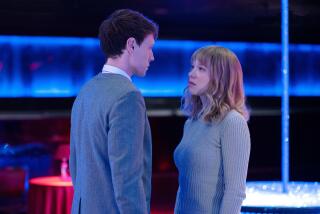‘Imitation Game’ needed to imitate Alan Turing’s code-breaking machine
One of the most important characters in “The Imitation Game” doesn’t say a word. It’s Christopher, a.k.a. the Bombe, an electro-mechanical code-breaking machine — a precursor of the modern computer — that helped save millions of lives during World War II.
“The Imitation Game,” which opens Friday, explores the life and work of the man behind the machine. One of England’s greatest WWII heroes, Alan Turing (played by Benedict Cumberbatch in the film) was a brilliant mathematician and cryptanalyst who, with an eclectic team, broke the previously unbreakable codes of Nazi Germany’s Enigma machine.
The film’s Turing machine is a mass of whirling dials, buttons and chunky red wires that resemble Medusa’s hair. The design is derived from the real Christopher, which Turing named after his first love, as well as from the imagination of production designer Maria Djurkovic (“The Hours,” “Tinker Tailor Soldier Spy”).
Djurkovic and the film’s director, Morten Tyldum, traveled to Bletchley Park, the central site of the United Kingdom’s Government Code and Cypher School, where a reproduction of the original Christopher is on display. The original machine was destroyed after the war.
“It has exactly those dials that you see in the film that turn at different speeds sequentially,” Djurkovic said in a recent interview. “However, when we stood there looking at the real thing, we both kind of looked at each other and said, ‘Not so visually interesting.’”
The machine rests within a Bakelite box — “sort of a big lump,” she said, with the dials in the front. “If you go around the back, it is rather more interesting, because you see the mechanics of it, the innards of its working. We decided then and there to take a little bit of artistic license.”
Djurkovic did a massive amount of research before she designed her Christopher.
“Bletchley was phenomenally helpful,” she said. “They have a real good archive. But once you have accumulated all of that knowledge, you can decide the bits to include and the bits to exclude.”
It was extremely important, she said, that Christopher’s innards were visible.
“We needed to be able to see the nerves of his machine,” she said. “The red wires are real, but our machine has considerably more. We also decided to make it slightly bigger. It’s probably 2 feet taller, [but] it is based very much on reality. Luckily, I had a very technically minded supervising art director.”
Producer Teddy Schwarzman said Djurkovic assigned one person full time to build the film’s Christopher, a machine that seemed mechanically faithful to its historical predecessor.
“Christopher was a massive undertaking. It was being built in a variety of different pieces,” Schwarzman said, noting that the result was “something that was actually operable and functioned with similar mechanics the way the Bombe had.”
Because Christopher is seen in three stages in the film, it had to be built in different layers that could be pulled apart depending on the scene.
“We needed those disks to move and move in a particular sequence,” Djurkovic said. “We had prop makers to make all of that function. The prop buyer managed to source all of these fantastic components that were all period-correct, and that makes a huge difference. We were lucky.”
The second Christopher, which is in Turing’s house in the early 1950s, is a smaller, modernized version of the first one.
“Christopher II had more artistic license,” Djurkovic said. “We put it into Alan’s house. The reality was it was at the University of Manchester. Morten wanted it to have echoes of Christopher I. I think in story terms, it was important to Morten that it did. I completely agreed.”
Twitter: @mymackie
More to Read
Only good movies
Get the Indie Focus newsletter, Mark Olsen's weekly guide to the world of cinema.
You may occasionally receive promotional content from the Los Angeles Times.







